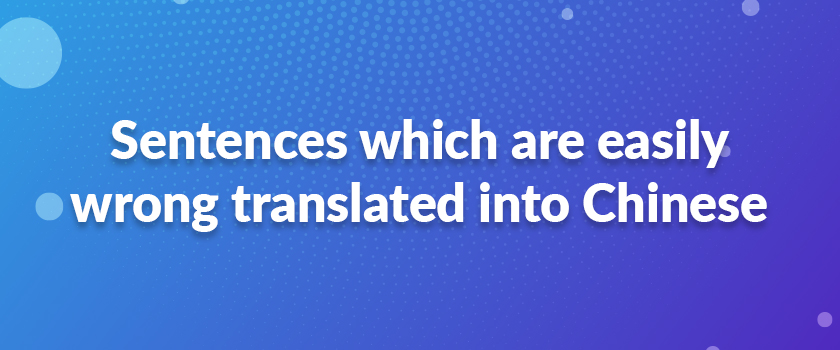Totally different meanings:
Totally different meanings are always caused by some phrases with special meanings. Let us look at the following sentences.
1. The country not agreeing with her, she returned to England.
Wrong: 那个国家对她有意见,所以她回到了英国。(word-for-word translation)
Right:她在那个国家水土不服,所以回到了英国.(Flexible translation)
Before translating this sentence, we need to figure out the meaning of “agree with”. This phrase has two meanings, one is “ 同意”, the other is “适合…体质”,this meaning is rarely used.
2. The monk is only not a dead man.
Wrong: 这个和尚不仅仅是一个死人。(word-for-word translation)
Right: 这个和尚虽然活着,但跟死了差不多.(Flexible translation)
Here “only not” does not mean “不仅仅”, but means “简直是, 几乎跟…一样”.
3. You don’t begin to understand what they mean.
Wrong: 你没有开始理解他们的意思。(word-for-word translation)
Right:你根本不知道他们在干嘛.(Flexible translation)
Here “don’t begin” does not mean “没有开始”, but means “决不”.
4. That’s all I want to hear.
Wrong: 这就是我想要听的全部。(word-for-word translation)
Right: 我已经听够了。(Flexible translation)
5. She held the little boy by the right hand.
Wrong:她用右手抓住小男孩。(word-for-word translation)
Right:她抓着小男孩的右手.(Flexible translation)
Here the subject of the action is totally with using “by” and “with”.
Read Also: Sentences which are easily wrong translated into Chinese ( To be continued)
6. .The elevator girl reads between passengers.
Wrong:开电梯的姑娘在乘客中看书。(word-for-word translation)
Right:开电梯的姑娘在没有乘客时看书。(Flexible translation)
Here the phrase “between passengers” does not mean “among the passengers”, but means “the time between the group of passengers goes and the next group comes”
Here “between “and “without” have the same meaning which should be translated into “没有”. For instance, the translation of“she modeled between roles.” Should be “她不演戏时去客串下模特。”.
7. If my mother had known of it she’d have died a second time.
Wrong:要是我妈妈知道了,她会死第二次的。(word-for word translation)
Right:要是我妈妈知道了,她会从棺材里爬起来。(Flexible translation)
8. You don’t want to do that.
Wrong:你不想那样做的。(word-for word translation)
Right:你不应该去做。(Flexible translation)
Awkward meanings: this kind of mistakes are always because the translator didn’t pay attention to the background knowledge or culture difference between TL and SL.
1. Do you have a family?
Wrong: 你有家庭了吗?(word-for word translation)
Right: 你有孩子吗? (flexible translation)
The reason why the word-for word translation is wrong is because in the English-speaking countries, family can only be called family when they have children, but not just a couple. That is a difference between Chinese and foreign cultures.
2. I have no opinion of that sort of man.
Wrong: 我对这类人没有任何看法。(word-for-word translation)
Right:我对这类人很反感.(Flexible translation)
There is difference between euphemism in Chinese and English. People of English speaking countries always use euphemism to express their bad feelings to somebody or something.
3. You don’t know what you are talking about.
Wrong: 你不知道自己在说些什么。(word-for-word translation)
Right:你在胡说八道.(Flexible translation)
4. I wish I could bring you to see my point.
Wrong: 我希望我可以带你去看看我所说的要点。(word-for word translation)
Right:你要我怎么说你才能明白呢.(Flexible translation)
5. He allowed the father to be overruled by the judge, and declared his own son guilty.
Wrong:他让法官征服了父亲,最终宣布他的儿子有罪。(word-for word translation)
Right:他让法官的职责战胜了父子的亲情,最终宣布儿子有罪.(Flexible translation)
6. You look darker after the holiday.
Wrong:假日回来,你看上去更黑了。(word-for word translation)
Right:假日回来,你看上去更健康了。(Flexible translation)
7. The presidents have been seen and not heard.
Wrong:有看过这个总统但是没有听过。(word-for word translation)
Right:这个总统有名无权.(Flexible translation)
8. My grandfather is nearly ninety and in his second childhood.
Wrong:我祖父快90岁了,正处于第二次童年期。(word-for word translation)
Right:我祖父快90岁了,什么事都需要别人来做。(Flexible translation)
There are still more examples which are wrong translated. To sum up, when translating or interpreting the daily conversation or literature works into Chinese, we should pay attention to the special usage of some phrases and also the . If not, we will become a laughingstock.
Take a look at how we helped our client by localizing their project for Chinese language. Click here to read the complete case study



